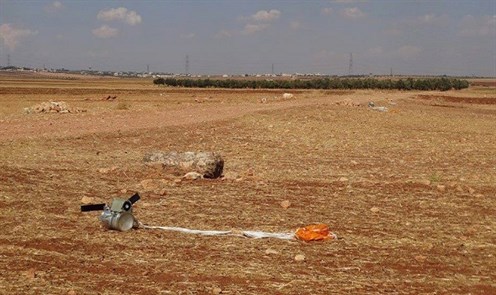12 October 2015
Is Russia Using Cluster Bombs in Syria?

SPBE sensor fuzed submunitions in countryside near Kafr Halab, Syria on 6 October 2015. ©2015 Shaam News Network
Following the beginning of Russia's air campaign in Syria, which started on 30 September 2015, Human Rights Watch has documented the use of an advanced type of Russian cluster munition in an airstrike southwest of Aleppo on 4 October 2015. It is the first time that this type of cluster munition (the SPBE sensor-fuzed submunition) is identified in Syria.
The Cluster Munition Coalition is very concerned with this new confirmed use of cluster munitions and calls on both Russia and Syria to refrain from using the internationally banned weapon, and to join the Convention on Cluster Munitions.
Based on available evidence it is not possible to conclusively determine if Russia is using cluster munitions in Syria or if it is providing the Syrian air force with this new type of cluster munitions to use.
Other types of Russian-made cluster munitions have been used by the Syrian government forces in the past.
Cluster munition strikes have an indiscriminate large footprint and leave behind unexploded submunitions that remain a fatal threat to civilians long after use.
Cluster munitions have been used in Syria since 2012, when Syrian government forces started using air-dropped cluster bombs on their own people. The non-state armed group Islamic State has also used cluster munitions in Syria, in 2014.
In a letter sent on day two of Russia's military action in Syria, the Cluster Munition Coalition warned Russia against using cluster munitions, on the grounds that these weapons are indiscriminate and have a disproportionate impact on civilians. Since 2012, the Cluster Munition Coalition has called numerous times on Syria to stop using cluster munitions.
In the last year, Russia added its voice to that of the dozens of states which expressed concern at cluster munition use in Sudan (UNSC Resolution of June 2015) and Ukraine (UN General Assembly First Committee on Disarmament and International Security, October 2014).
To date 118 states have joined the Convention on Cluster Munitions, of which 98 are States Parties.


